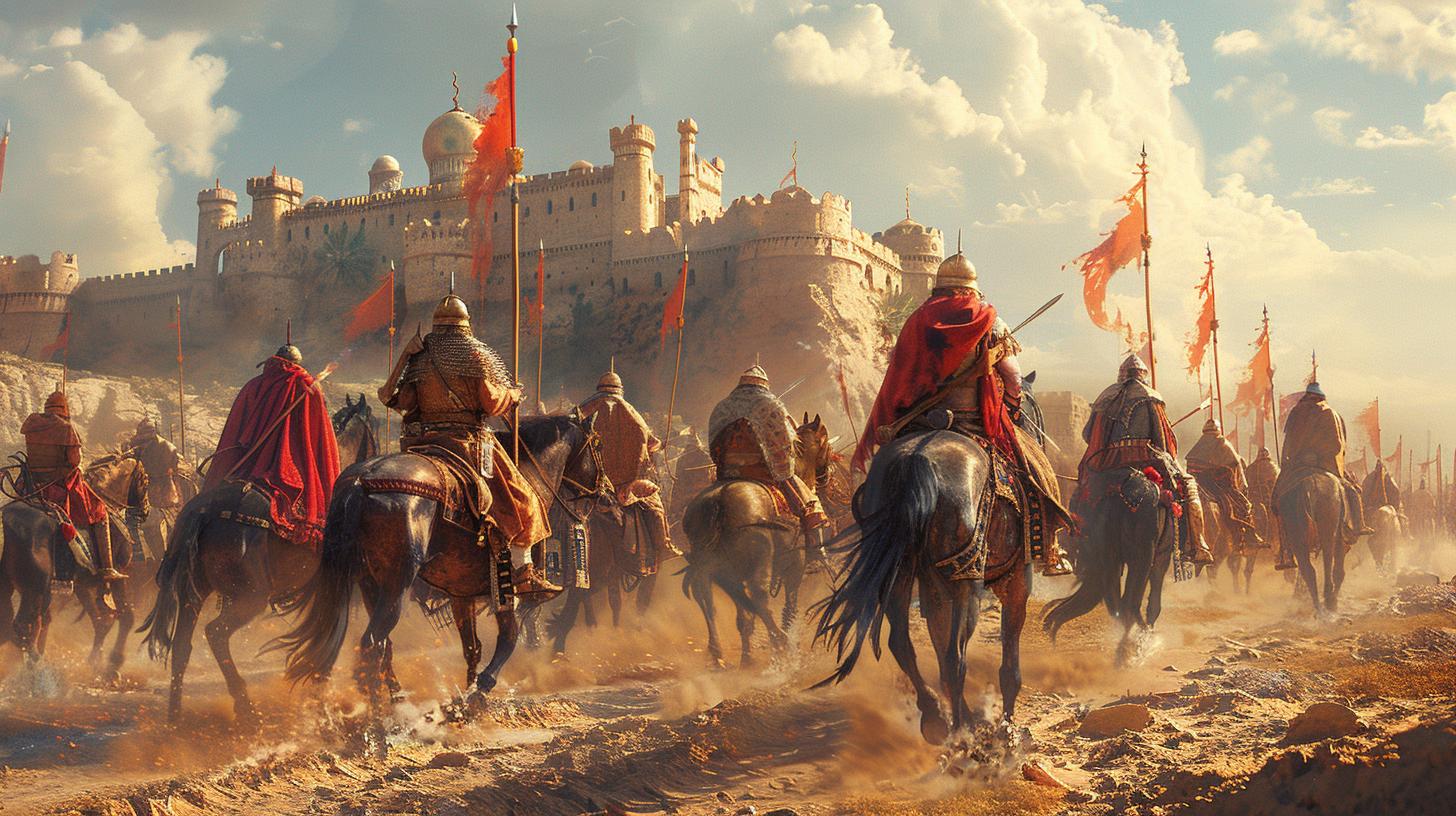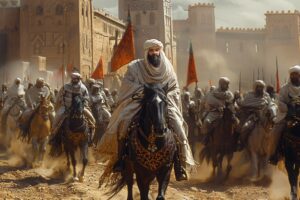King Massinissa: The Legendary Numidian Warrior-King

Masinissa, the legendary Numidian king, rose to power during the Second Punic War, solidifying Numidian dominance in North Africa. His strategic alliances with Rome and military prowess contributed to the downfall of Carthage.
Masinissa’s legacy as a unifying leader and visionary military strategist remains influential in North African history and culture today.
The Early Life of Masinissa
Masinissa’s early years were shaped by his upbringing in Carthage and his introduction to the world of military training and warfare. His childhood in Carthage exposed him to the political and military dynamics of the region, laying the foundation for his future leadership.
Childhood in Carthage
- Early Exposure to Politics and Diplomacy
- Cultural Influences in Carthage
- Relationship with Carthaginian Elite
Military Training and Early Battles
- Education in Warfare Tactics
- Experience in Tribal Conflicts
- Strategic Thinking and Decision-Making
Rise to Power
Upon the death of his father, Masinissa ascended to the throne of the Numidian tribes, facing the challenge of uniting the disparate factions under his rule.
Succession and Unification of Numidian Tribes
Through strategic alliances and diplomatic maneuvers, Masinissa succeeded in consolidating his power and bringing together the nomadic tribes of Numidia.
Alliances with Rome and Involvement in the Punic Wars
Recognizing the growing power of Rome, Masinissa forged key alliances with the Roman Republic, aligning Numidia’s interests with those of the burgeoning superpower. His involvement in the Punic Wars solidified his reputation as a formidable leader on the Mediterranean stage.
Reign of Masinissa
Known for his military prowess and strategic vision, Masinissa led successful military campaigns to expand Numidian territory, establishing his dominance in North Africa.
Military Campaigns and Conquest
- Conquering neighboring tribes with calculated precision
- Utilizing guerrilla tactics to outmaneuver larger armies
- Expanding Numidian influence through strategic alliances
Relations with Rome and Carthage
- Forging strong ties with Rome through mutual interests
- Navigating diplomatic tensions with Carthage
- Balancing alliances to maintain Numidian sovereignty
Legacy and Impact in North Africa
- Establishing a powerful Numidian kingdom that endured for generations
- Shaping the political landscape of North Africa for years to come
- Inspiring future leaders with his strategic acumen and unity-building efforts
Masinissa’s Military Strategies
When it came to military tactics, Masinissa was a brilliant strategist whose innovative approaches set him apart on the battlefield.
Tactics in Battle Against Carthage
- The use of guerrilla warfare tactics to disrupt Carthaginian supply lines.
- The employment of swift and decisive cavalry charges to outmaneuver the enemy.
- Strategic ambushes in difficult terrain to surprise and overwhelm Carthaginian forces.
Innovation in Numidian Cavalry
One of Masinissa’s key military innovations was the development of the Numidian cavalry, which became renowned for its speed, agility, and fierce close combat skills.
- Training exercises focused on rapid maneuvers and coordinated attacks.
- The use of specialized cavalry units for reconnaissance and hit-and-run raids.
- Adaptation of Numidian horses for long-distance travel and endurance in battle.
Masinissa and Scipio Africanus
Masinissa’s collaboration with Scipio Africanus during the Second Punic War marked a significant turning point in North African history.
This alliance between the Numidian king and the Roman general played a crucial role in the ultimate defeat of Carthage.
Collaboration in the Second Punic War
During the Second Punic War, Masinissa formed a strategic partnership with Scipio Africanus, aligning Numidian forces with the Roman Republic against the Carthaginians. This alliance strengthened their military capabilities and provided a decisive advantage on the battlefield.
Role in the Battle of Zama
At the Battle of Zama in 202 BC, Masinissa’s Numidian cavalry played a pivotal role in securing victory for the Roman forces led by Scipio Africanus. Masinissa’s tactical brilliance and skilled leadership contributed significantly to the defeat of Carthage and the consolidation of Roman power in North Africa.
Numidian Society Under Masinissa
Numidian society under the rule of Masinissa underwent significant transformations, particularly in the realms of economic policies and agricultural practices. Additionally, Masinissa implemented social reforms that aimed to foster unity among the diverse Numidian tribes.
Economic and Agricultural Policies
- Implemented land redistribution policies
- Promoted irrigation techniques for agriculture
- Encouraged trade with neighboring regions
Social Reforms and Unity Among Tribes
- Established a council of tribal leaders for decision-making
- Promoted cultural exchange and cooperation among tribes
- Encouraged intermarriage to strengthen alliances
Masinissa’s Legacy
King Masinissa left a profound impact on the history and culture of North Africa, shaping the region for generations to come.
Historical Influence in North Africa
Masinissa’s reign established a legacy of unity and strength among the Numidian tribes, contributing to the cultural identity of the region.
Reflection in Art, Film, and Literature
- Artists and writers have often depicted Masinissa as a symbol of leadership and resilience in their works.
- His story has been portrayed in various forms, inspiring creativity and reflection on the complexities of power and legacy.
Challenges and Conflicts
Challenges and conflicts arose during Masinissa’s reign, shaping the political landscape of Numidia.
Rivalry with Syphax and Hasdrubal
The rivalry between Masinissa and Syphax, a Numidian rival, fueled tensions in the region. Additionally, conflicts with Hasdrubal, a Carthaginian general, further complicated Masinissa’s political endeavors.
Syphax’s Ambitions
- Syphax’s ambitions for power clashed with Masinissa’s goals, leading to territorial disputes.
- The competition between these two leaders intensified as alliances shifted and loyalties were tested.
Hasdrubal’s Threat
- Hasdrubal’s military strategies posed a significant threat to Masinissa’s kingdom, prompting defensive actions.
- The constant threat of Carthaginian influence challenged Masinissa’s authority and control over Numidia.
Opposition Against Roman Influence
As Masinissa strengthened ties with Rome, opposition against Roman influence grew among rival factions.
Numidian Resistance
- Some Numidian tribes resisted Roman interference, fearing the loss of autonomy and cultural identity.
- The clash between pro-Roman and anti-Roman sentiments heightened internal conflicts within Numidia.
Political Tensions
- Roman intervention in Numidian affairs created political tensions, challenging Masinissa’s diplomatic skills.
- The struggle to balance Roman allegiance with Numidian independence led to complex diplomatic negotiations.
Late Reign and Death of Masinissa
The final years of Masinissa’s rule were marked by succession struggles and political turmoil that shook the foundation of Numidia.
Succession and Political Turmoil
After ruling for over five decades, Masinissa’s advanced age raised concerns about succession. His sons vied for power, leading to internal strife and instability within the Numidian tribes.
End of Masinissa’s Rule and Impact on Numidia
Upon Masinissa’s death in 148 BC, Numidia faced a period of uncertainty as power struggles intensified.
The vacuum left by his absence sparked conflicts and power shifts, altering the political landscape of the region.
.




















